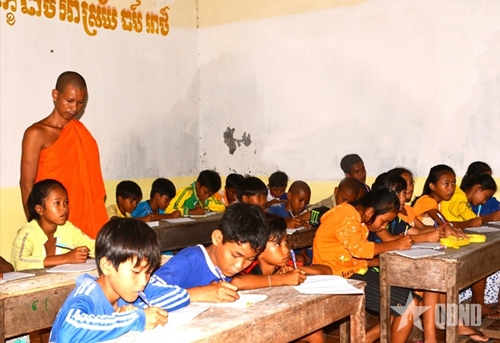Pagoda’s yard echoes with children's voices
Early one morning in June, before the first rays of sunlight pierced through rows of palm trees, the yard of Som Rong Pagoda was already bustling with the footsteps of young students. Groups of children, arms full of books, chatted excitedly as they headed to a special classroom, the summer Khmer language class organized by the pagoda.
    |
 |
|
During the Khmer language class |
This year’s class has attracted around 150 children from grades 1 to 5. Regardless of their background or starting level, all are warmly welcomed by the kind and dedicated monks. Inside a spacious, cool classroom beneath an ancient roof, rows of desks and chairs are neatly arranged. A blackboard stands at the front.
Venerable Lam Binh Thanh has been closely involved with these classes for many years. For over a decade, he has thoughtfully prepared lessons for children, teaching not only the Khmer language but also moral values, history, and the cultural traditions of the Khmer ethnic group.
In class, the voices of teacher and students blend into a warm and energetic atmosphere. Son Quanh Tha, a first-time student, shared that he was initially nervous because he couldn’t read or write Khmer. “But the monk patiently held my hand and guided me stroke by stroke,” he said. Now he knows the consonants and vowels. He enjoys the lessons and is determined to do well in the final exam.
Script a bridge of culture
In today’s Can Tho, and previously in Soc Trang, the Khmer community has long regarded its language and script not just as communication tools, but as the soul of its culture. As such, summer Khmer language classes held at pagodas have become a cherished tradition. These literacy classes are more than educational programs. They reflect a community’s commitment to preserving its heritage.
Beyond Som Rong Pagoda, several other local Khmer temples, such as Serey Pothi Dom Po, Mahatup, and Sala Pothi Serey Sakor, also offer free Khmer language classes during the summer.
These classes have become spaces for community bonding and offer children a safe, enriching alternative to screen time or idle games. In these vibrant cultural environments, children learn in a setting filled with care and compassion, an education that nurtures both intellect and character.
For Venerable Lam Binh Thanh and the other monks, maintaining these classes is not just a duty; it’s a heartfelt mission. It is their way of keeping the cultural flame alive in the next generation. Support from the pagodas, families, the education sector, and local authorities forms the foundation for the sustainability and growth of these classes. Many Khmer teachers from the formal school system also join in, helping to build a strong bridge between tradition and modernity.
Translated by Quynh Oanh